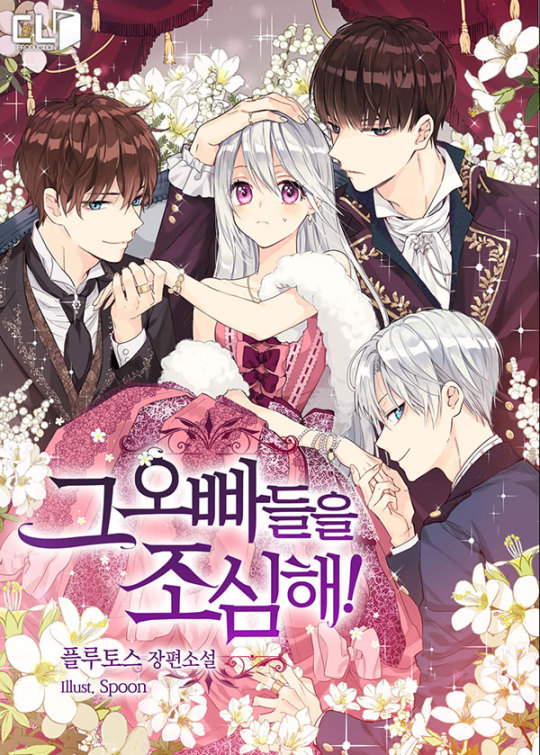
I recently read some of the comic Beware of the Brothers! (그 오빠들을 조심해!) and my eyes were drawn to the clothes and what they could mean. I was really interested in the two youngest Ernst children, Hari–the adopted daughter–and Eric–the twin without a twin.
If you’ve read the story, you know that Hari was brought in, at first, as a replacement for the daughter that the Ernst family lost. Quickly, Eugene puts an end to the “replacement” fantasy of his parents and luckily we never went through the common trope of Hari being miss-named, which would have undoubtedly been more traumatic for everyone of the characters. Instead, the story progresses quickly, allowing Hari to adjust to her restarted life as the adopted child of a noble family. It also allows me to get to the point I want to make in this review of the fashion choices by the creator(s) of the series.
Tell me, what do you think of when you see a pair in matching outfits? If the people look alike or are children, I generally think twins or siblings. I mean, I have two nieces that are a little more than a year a part who are always dressed the same by their mother. It’s a thing. And, as a middle schooler I regularly found myself “twinning” with my besties. As an adult, especially consider the media I consume, I noticed couples wearing matching and complimentary outfits–a topic I believe I have mentioned before but will mention again here.
Matching outfits and complementary outfits are my favorite in any visual media. I particularly love matching outfits in comics since it usually symbolizes one of two things–love interests and or a mental connection with another person. You see it often in uniforms or coupled outfits, and when the pairing or unit is in distress, the first thing that is usually replaced, thrown out, or lost is that matching element.
Which is why I am fascinated by Hari and Eric in Beware of the Brothers!.
The two youngest siblings are not twins even though they really do look like it in many regards. We know that Hari is almost a spitting image of the late Ernest daughter, save for her eyes, based on other images, but still they have no blood relationship with each other as far as we, the audience, know and as far as they, the siblings, know. The Ernest couple never mention a lost cousin, a bastard child, or anything else, so in all regards Hari really is randomly a spitting image of their late blood relation and yet not one. This is actually a major point of strife among the four siblings (three blood related boys and Hari) in the beginning, ESPECIALLY for Eric who lost his twin.
Eric and Hari, therefore, do NOT get along in the beginning. Arguably, it takes these two the longest to come to terms with each other over all. In fact, Hari admits to them being down right violent with each other at first–with the two going so far as to kick, trip, and push each other. Additionally, we see that being compared or thought of as twins is really strikingly hard on Eric when the one time it does happen in the series, he runs away:

But it’s hard not to see them as such when you look at how they are dressed and behave as the work continues.
Early in the series, they always wore different clothes, example:
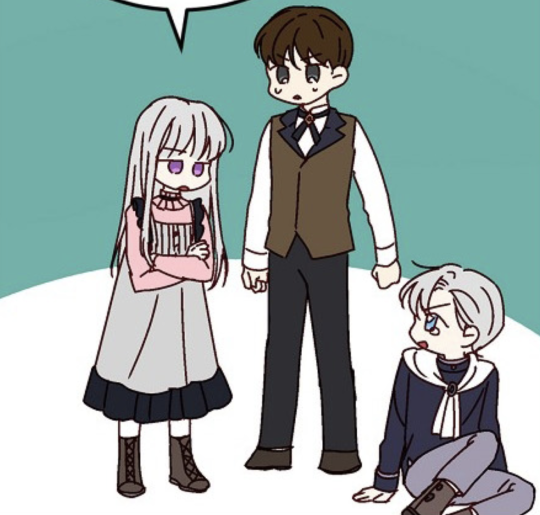
Hari has a pink and grey color scheme in the image above, while Eric is wearing blues and white. The costumes aren’t complementary colors, they don’t match and they’re obviously different designs even in chibi style.
But in the moment they are compared as twins, they look like this:
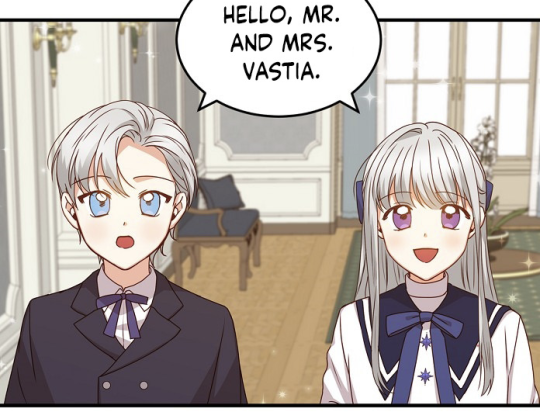
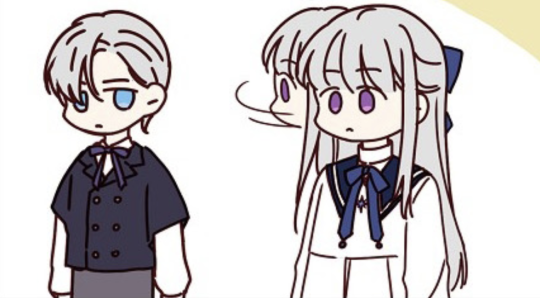
Their colors are in the same family and the the designs are similar–more so than when compared to any of the other siblings–and, they’re both missing front teeth in this scene. They were dressed like twins in that moment. Definitely with a variation of color, but ultimately very close.
Then we see the pattern repeated once they grow up.
For example, here they are as teens:
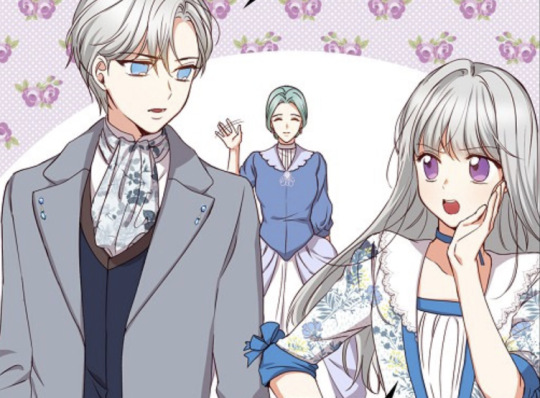
And again:
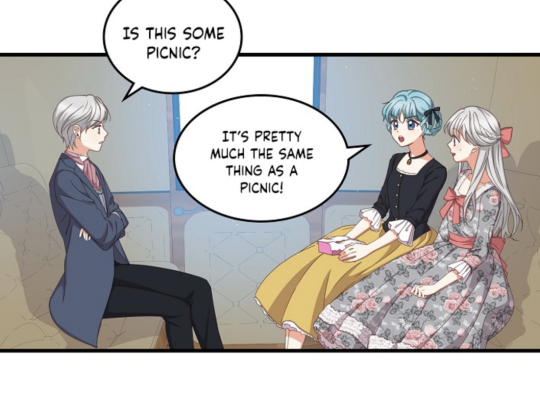
Even in later scenes as children:
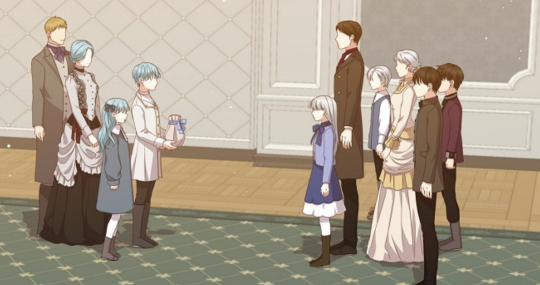
Did you notice the pattern?
The two are wearing clothes in similar color families. Eric and Hari wear matching patterns, with Eric having a darker corresponding color to Hari’s pastels in most shots. Even in the last image where they stand as children saying goodbye to the Vestia family, Hari and Eric are the only ones in a blue color scheme from their household. If she wears light blue, he wears dark. Her dress has pink flowers on a blue-grey background, Eric wears a dark blue grey coat with a darker pink ascot. Finally, in the image directly above, Eric is wearing a lavender-blue in between the two lavender-blues of Hari’s outfit.
They match.
We see this style of matching/complimentary color schemes with the Vestia children too:
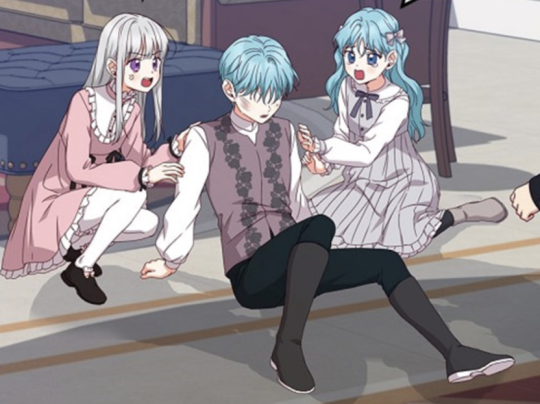
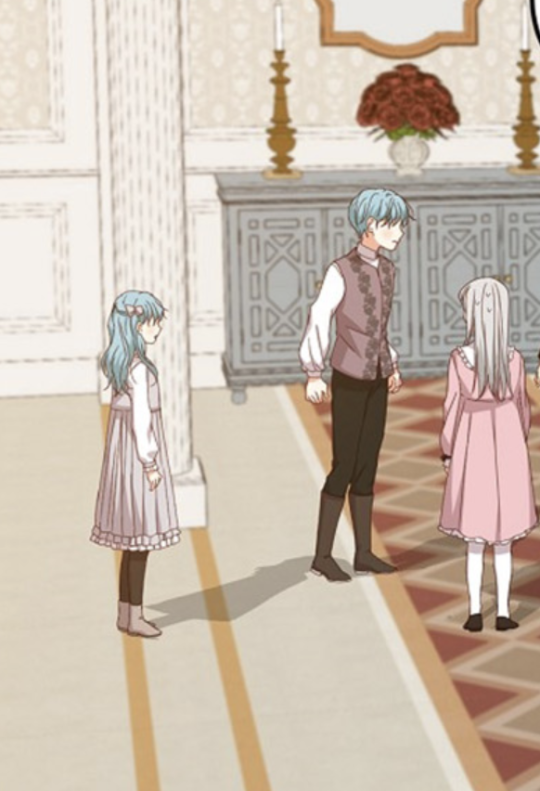
The off-whites of the two siblings are the same, the blacks are the same shades and both on their legs, the grey toned vest (boy) and dress (girl) are similarly tinted from the same purple-pinkish family.
It actually feels very telling in this scene that Hari is closer to the two blue-haired siblings than her three brothers as Hari’s pinks match well/complement the purple-pink tinted grays seen on the Vestia siblings (more so than with Cabel’s blues and browns or the other boys):
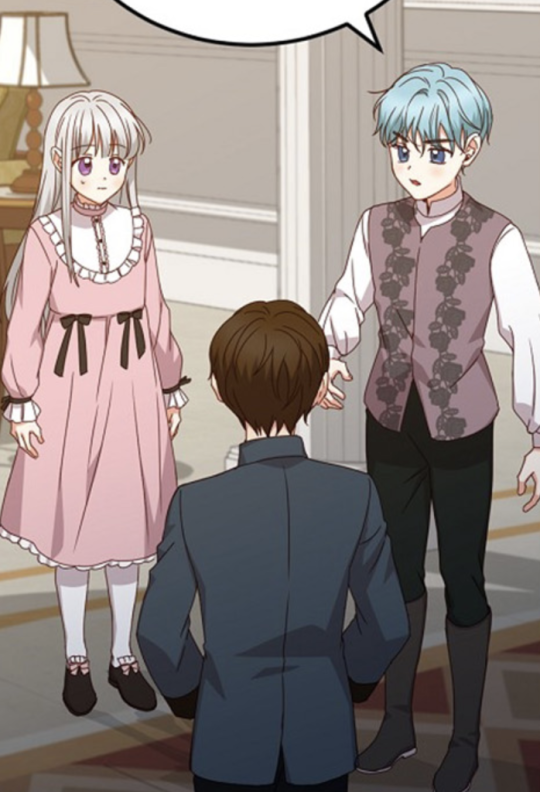
What could this mean?
Are Hari and Eric meant to be shipped based on their outfits? I vote NO (strongly). Instead, I believe it suggest a kinship that they share which becomes stronger than with the other brothers.
Perhaps the two are “astral twins,” born at the same time but to different parents or perhaps they simply represent a gemini set of paradoxes or conflicting ideas–at least, that would be my theory.
They are twins who aren’t twins and they both, whether they want to admit it or not, have a strong connection that comes across in Chapter 36 as we find the two awake in the middle of the night talking where Eric asks Hari whether she likes Johan or not. It shows their differing opinions on the subject of discussing likes/dislikes and, even though they aren’t in matching outfits, it’s pretty clear that more and more they have a strong mental connection that doesn’t feel inncestrious or sexual.
I really hope that the creator develops more on this, preferably not leading (as the cover image at the top seems to imply) to a harem of brothers. I think a found-family story is much better served when Johan is such a capable romantic lead.
But what are you all thinking? How do you feel about the twins that aren’t twins idea? Let me know!
